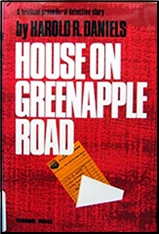Tue 19 Apr 2022
A 1001 Midnights Review: HAROLD R. DANIELS – House on Greenapple Road.
Posted by Steve under 1001 Midnights , Reviews[5] Comments
by Bill Pronzini
HAROLD R. DANIELS – House on Greenapple Road. Random House, hardcover, 1966. Dell, paperback, 1969. [See comment #2.] TV movie: Quinn Martin, 1970.

The “Red Kitchen Murder,” as it came to be known in the press, began when Marian Ord’s nine-year-old daughter returned home from school to find “brown stuff … like paint or when you spill iodine” all over the kitchen of their tract house on Greenapple Road in the small Massachusetts town of Holburn.
Marian’s sister-in-law, who lived next door, called the police. But there was no body in the house or anywhere else in the vicinity. What had happened in that kitchen? Where was Marian Ord, dead or alive?
Dan Nalon was in charge of the investigation. Along with his fellow officers, he began probing into Marian Ord’s background-and found a maze of twisted relationships that proved she was anything but an average suburban housewife. Among her “friends” were a phony minister, head of the “Church of Redemption Through Love”; a cruel and selfish ski instructor; a decent young Italian biker; an equally decent young lifeguard at the local country club; a big-shot bookie known to have Cosa Nostra connections; and a succession of men she picked up in bars.
She was also guilty, Nalon discovered, of passing bad checks, welshing on gambling debts, and stealing money from her tavern conquests.
When it became apparent that her husband, George, knew of Marian’s sleazy “other life,” and that his alibi for the time of the Red Kitchen incident was not what it first seemed, Nalon’s attention focused on him- But had Ord really killed his wife in a fit of jealous rage? Just what had happened that tragic afternoon in the house on Greenapple Road?
This is a taut and baffling thriller, told in a semi-documentary, ex-post-facto style that makes excellent use of flashbacks. The characterization, especially of Marian 0rd, is of the first rank; the writing is crisp (and there is plenty of sex to spice the narrative); and the revelations at the climax are surprising, yet fairly clued.The film version, made for TV in 1970 with Janet Leigh and Christopher George, is faithful to the novel and just as suspenseful as a result.
Daniels published several other novels of merit in the Fifties and Sixties, all of them paperback originals; the best are The Accused (1958), The Snatch (1958), and For the Asking (1962).
———
Reprinted with permission from 1001 Midnights, edited by Bill Pronzini & Marcia Muller and published by The Battered Silicon Dispatch Box, 2007. Copyright © 1986, 2007 by the Pronzini-Muller Family Trust.
April 19th, 2022 at 4:17 pm
What seems strange to me is that the book never came out in paperback. It seems like a natural to me.
I seem to remember that GREENAPPLE ROAD was the very first TV movie to be made. and at the time a big to-do was made of the fact, but I could be wrong abut this.
Christopher George’s role in the TVversion was Lt. Dan August, who as a character in his own series was played by Burt Reynolds.
April 19th, 2022 at 7:19 pm
HOUSE ON GREENAPPLE ROAD
A DElL Paperback
Copyright 1966 by Harold R. Daniels
Reprinted by arrangement with Random House, Inc.
First Dell Printing – July 1969
I’m holding my copy in my hand as I’m typing this (I got it third-or-fourth-hand in a used bookstore some number of years ago – I recognized it from the TV movie.)
As noted in earlier posts here, the TV-movie was filmed in 1968; guessing here that Dell was expecting a movie release (TV or maybe theatrical) in ’69, but Fate Intervened.
My 1969 copy of House is somewhat worse for the wear (it was when I got it, comes to that), but it is readable, and I keept in a safe place, with other works by Harold R. Daniels (which I learned about here, for which deep thanks).
Fun Fact:
In the back cover blurb, Lt. Nalon’s name is spelled Nolan; these things happen …
April 19th, 2022 at 7:31 pm
Thanks for correcting me about the paperback edition. I thought I was crazy when I went looking for information about it online and I couldn’t find a single copy offered for sale anywhere.
I knew there was a Dell edition, and I could even see its cover, clear as day in my mind. And yet no copies online? It should be as common as all get out, but it’s not.
April 20th, 2022 at 8:43 pm
Both book and film are somewhat lost classics, though not impossible to find. I saw the movie first then went looking for the book.
July 16th, 2023 at 11:29 am
Belatedly (but I can’t resist):
I was looking through my old EQMMs, and happened to find this little notice in Anthony Boucher’s review column for July 1966:
**** HOUSE ON GREENAPPLE ROAD, by Harold R. Daniels (Random, $3.95)
Strikingly successful effort to create murder fiction in the manner of the best fact-crime, with a memorable full-length portrait of a self-destructing woman.
When he did his year-end summary in the March 1967 EQMM, Boucher included House On Greenapple Road in his best-of-the-year list.
Tony Boucher didn’t live to see the TV-movie – I wonder what he would have thought about it …
By the bye, if any of you ever saw how Boucher reviewed the book in the New York Times, you might like to pass it along here …